Justified or 'unacceptable?' What hours of body-cam footage from Copley Road protest shows
An Akron protester taunted a line of police officers and deputies during an April 19 protest on Copley Road, warning them they were being watched.
“Don’t stand there!” he said, using a device to amplify his voice. “Come on! Attack us! Come on! We got the news. The news is here. We need them to watch how you act for no reason. Come on! We’re waiting for you guys.”
“Stay out of the street!” responded one of the Summit County Sheriff’s deputies who wore black SWAT uniforms, gas masks and helmets.
As the deputies and Akron officers advanced toward the protesters, they were hit by water bottles, body-worn camera videos reviewed by the Akron Beacon Journal show.
The deputies and officers then deployed pepper spray, tear gas and smoke bombs to disperse the crowd. The protesters, as well as people on sidewalks and nearby journalists, were hit with the chemical irritants.
Lawsuits: What's happening with 3 lawsuits against Akron for Jayland Walker's shooting and protests?
Akron Councilman Shammas Malik, the next presumptive mayor after winning in the May Democratic primary, called the officers’ use of pepper spray on a crowd that included children and people who had left the road and were complying with police orders “unacceptable.”
Four months later, the officers’ actions at this protest are the subject of a federal lawsuit. The lawsuit claims police violated protesters’ constitutional rights by using excessive force in the Copley Road protest, as well as making unwarranted arrests and towing protester’s vehicles.
To determine what really happened at the Copley Road protest, the Akron Beacon Journal watched hours of video from 25 body-worn camera videos and three Ohio State Highway Patrol drone videos, reviewed police reports and court documents and talked to people who were at the protest.
Protest follow’s grand jury’s decision in Walker’s shooting
The Copley Road protest was in response to the announcement on April 16 that the Akron officers who shot and killed Jayland Walker wouldn’t face criminal charges.
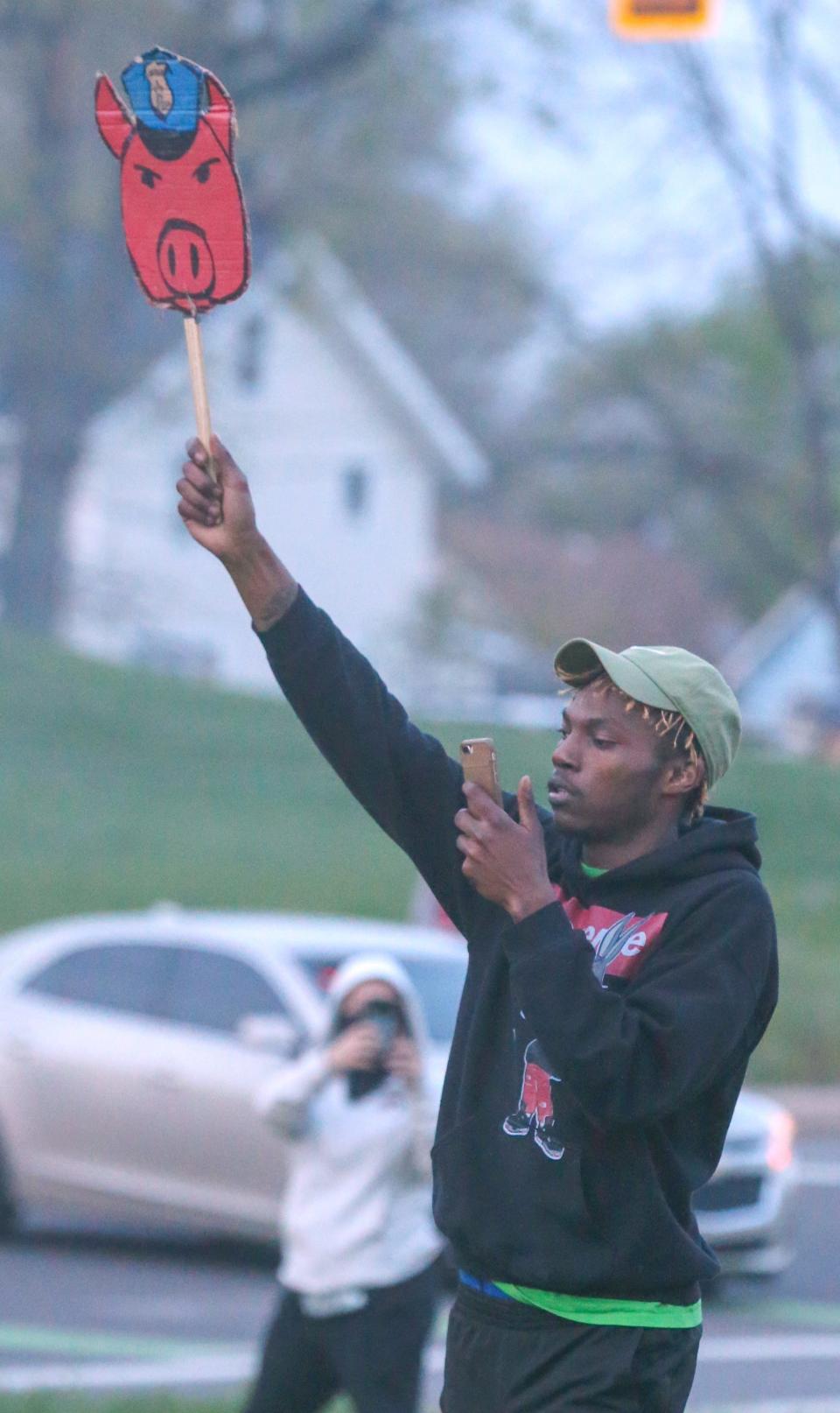
Walker, 25, was shot by police more than 40 times on June 27, 2022, after he fled from police in his vehicle and then by foot. He was unarmed but investigators determined that he fired a shot out of his car window. A gun was found in his car.
After his shooting, numerous people protested in downtown Akron. More than 50 people were arrested, several downtown businesses’ windows were damaged and fires were started.
Following the grand jury’s decision in mid-April, Akron braced for more protests, with the city setting up a designated protest zone on High Street and erecting a fence around the courthouse.
Rather than large protests downtown, though, the city saw mostly smaller gatherings and marches in neighborhoods. A few windows were broken in Highland Square and downtown.
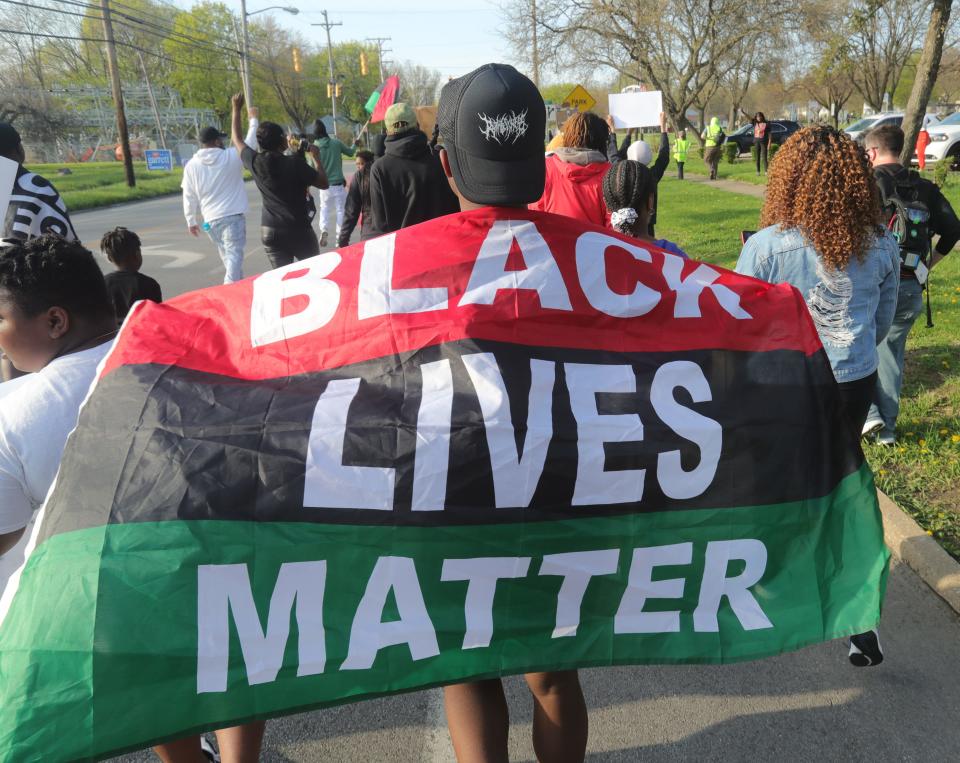
The largest protest happened on the evening of April 19 and was organized by Alexis Walker, Jayland Walker’s cousin. It started around 6 p.m. at Hawkins Plaza with about a dozen people who went north up South Hawkins Avenue to Copley Road.
What body-worn police video camera footage shows
Footage captured on police body-worn camera and drone videos show numerous vehicles and people joined in the protest. All three lanes on Copley Road were eventually blocked. At one point, there were more than 75 cars on the road and about 100 protesters.
That’s when Akron police officers and Summit County Sheriff’s deputies arrived. About 8 p.m., they parked their cruisers and a black, armored Summit County SWAT vehicle behind the row of stopped traffic.
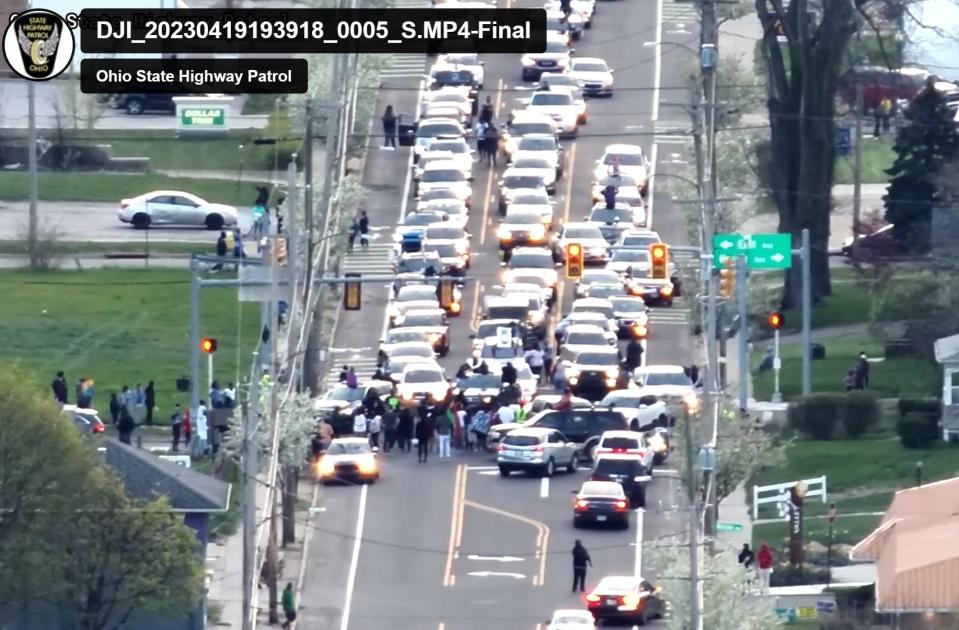
Numerous protesters wound their way through traffic, lining up opposite a line of officers and deputies.
A man waved a Pan-African flag, while several others held signs with messages like, “Black Lives Matter” and “Jayland Walker RIP.”
“Get out of the street or you will be sprayed,” yelled a deputy holding a pepper spray cannister.
“I hate you all!” a woman told the officers.
This video shows protesters holding signs and some of them yelling at officers. Officers warn the protesters to get out of the street or they will be pepper sprayed. Officers walk toward the protesters, spraying pepper spray at them. The protesters run. The officers stop so they don't walk into the path of the spray. At the end of the video, an officer points as an item is thrown by a protester on the sidewalk.
An officer said, “Move,” and he and several other officers and deputies walked toward the protesters, spraying pepper spray in front of them.
The protesters scattered to try to avoid being sprayed.
“Watch rocks!” an officer said. “They’re tossing rocks!”
Some deputies walked back to their cruisers and put on helmets. Several also got cannisters of tear gas.
Deputies next use smoke bombs and tear gas on protesters
With some protesters and vehicles still in the middle of Copley Road, deputies gave them a final warning.
“Clear the streets or chemical munitions will be deployed,” a deputy announced over a public-address system. “This is unlawful assembly.
Deputies walked in a line up Copley Road, throwing smoke bombs and tear gas at the protesters. Smoke rose in several places in the street.
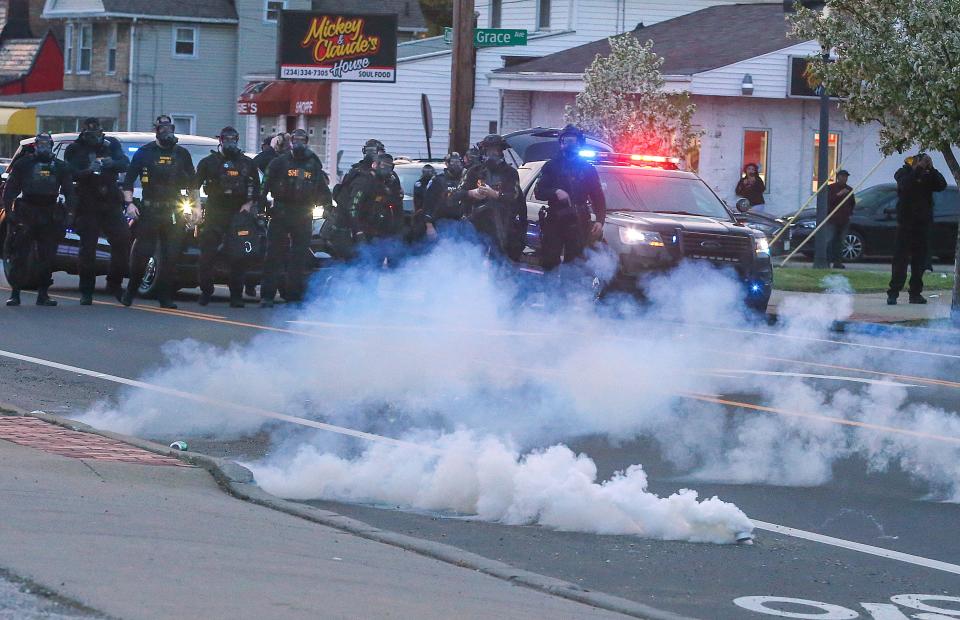
The deputies continued to advance, with the cruisers and SWAT vehicle moving behind them.
This video shows deputies giving protesters a final warning to get out of the street or chemical irritants will be deployed. Deputies then shoot or throw tear gas and smoke bombs at the protesters, who run. Smoke can be seen in several places in the street.
A woman came toward the deputies in the middle of the street and shouted, “Justice for Jayland.” She pumped her fist in the air.
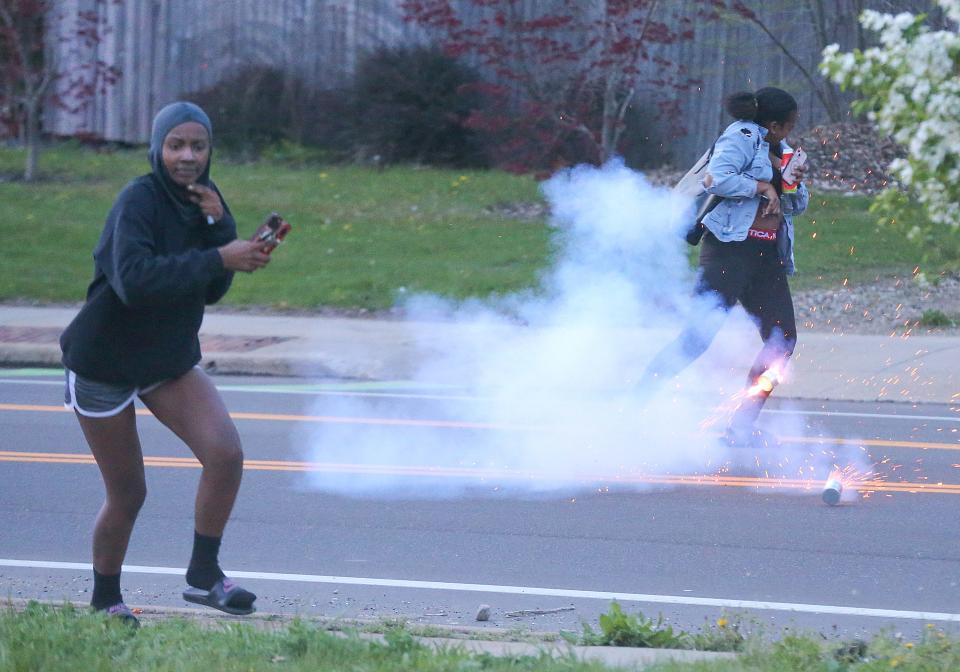
A deputy threw a cannister toward her and she ran.
This video shows the woman walking toward deputies with her fist in the air. Deputies throw a cannister at her that emits smoke and she runs. Protesters can still be heard chanting.
A water bottle skidded along the ground toward the deputies, stopping short of them.
By this point, so much smoke hung in the air from the tear gas and smoke bombs that it obscured a drone camera’s view of the area.
The remaining protesters turned up East Avenue, leaving Copley Road clear besides the officers, deputies and their vehicles.
“The reason for this was to open Copley Road – and it worked,” a deputy said. “We got Copley Road open.”
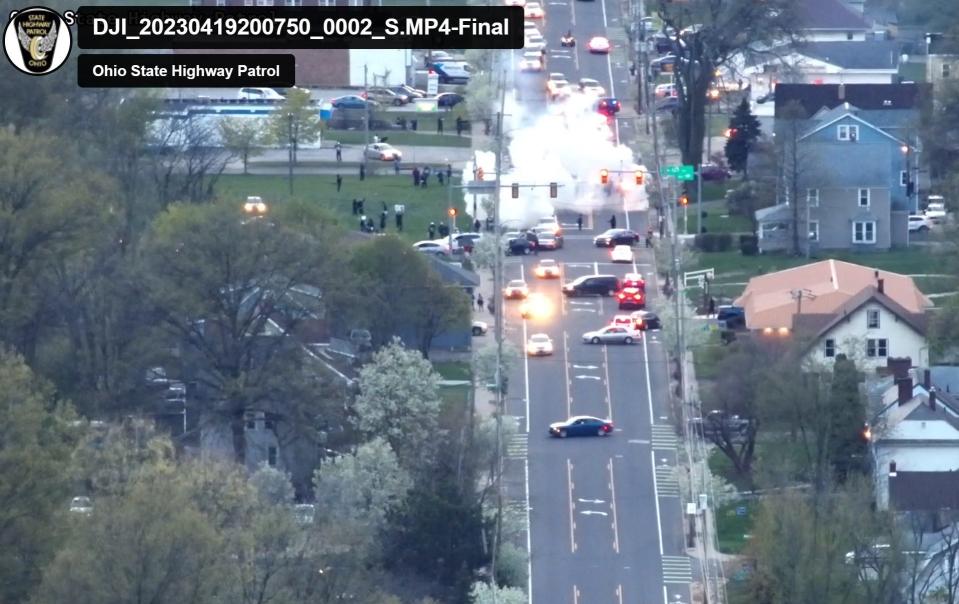
Police chief defends actions of officers
Akron Police Chief Mylett defended the actions of the officers and deputies in a video message posted April 22 on the department’s Facebook page.
Mylett said officers didn’t intervene in the protest for nearly two hours. He said they responded after all three lanes of Copley Road were blocked and emergency vehicles wouldn’t have been able to get through.
“Officers gave multiple orders to disperse before deploying chemical irritants,” Mylett said in a nine-minute video message.
More: APD video shows Jayland Walker protesters throwing items before officers used chemicals
Akron Fire Lt. Tim Morrison, a now retired spokesman for the fire department, said no emergency vehicles were impeded from responding to calls in the Copley Road area because of the protest.
In June, Mylett told the Beacon Journal that officers responding to the Copley Road protest had been briefed on social media threats of violence, including an April 18 post on the mayor’s Twitter page that showed how to turn a plastic bottle into an incendiary device. That, in part, is why officers responded the way they did, the chief said.
The body-worn camera videos show several water bottles being thrown at officers, with one hitting an officer who yelled and jumped around.
This video shows a deputy on the right side of the screen who gets hit with a water bottle. He yells and jumps around. The water bottle can then be seen in the road.
In another video, a deputy was hit by something that knocked off his helmet. It is unclear what hit him.
No rocks or bricks can be seen being thrown in the videos, though officers warn each other about this happening in the radio traffic.
“While some may not agree with the use of chemical irritants, the facts remain that when people start throwing objects at police officers, they are no longer peaceful,” Mayor Dan Horrigan said in an April statement.
Four people arrested but none for throwing items at police
No one was arrested at the Copley Road protest for throwing items at officers, police said.
Asked for any incident or supplemental reports of arrests at the protest, Akron police provided two reports.
One was for three men who were arrested April 19 on South Hawkins Avenue after being pulled over for blocking roads in the protest caravan. Two men were arrested for drug or weapons offenses for items found on them or in the vehicle, while the third was charged with several traffic violations.
The other arrest involved a woman charged with willful fleeing and traffic violations.
More: 'Problematic and dangerous': City advises against bringing kids to protests in open roads
The Akron Police Department is still finalizing a use-of-force investigation into the response of both police and sheriff’s deputies at the Copley Road protest.
Akron police supervisors declined to answer questions about the protest beyond the statements Mylett had made.
Inspector Bill Holland, a spokesman for the Summit County Sheriff’s Office, declined to discuss the protest, pointing to the pending lawsuit.
City Council members and local activists criticize officers’ response
Several Akron City Council members and local activists were critical of the officers’ actions during the protest.
More: 'It just made matters worse.' Critics question police use of tear gas at Akron protest
Councilman Russ Neal, whose ward includes part of Copley Road and who was at the protest, said the officers’ actions “made matters worse.”
Neal said in a recent interview that he was returning home from a community meeting when he saw all the cruisers on Copley Road. As he walked up to see what was happening, he saw deputies throw tear gas and smoke bombs at the protesters. He said he tried to call Mylett but was unable to reach him, and asked a police sergeant if he could talk to the protesters.
Then, Neal said, deputies threw more tear gas cannisters.
Neal said he heard about people who had injuries to their eyes and breathing issues from being exposed to the tear gas and pepper spray. He said his eyes and breathing were irritated.
“The more frustrating thing was just seeing this happen right in the heart of the neighborhood – and just the strong disconnect between those called to protect and serve and the community,” he said.
Neal, who lost his council seat in the May primary, thinks the city needs to learn from what happened at this protest. He said protesters should be given the opportunity to express themselves.
“We all know it could have been handled differently,” he said.
Akron group files lawsuit against the city
The Akron Bail Fund, a nonprofit group that assists protesters, filed a federal lawsuit against the city two days after the Copley Road protest.
The Bail Fund and the city agreed on a temporary restraining order that said the city or any other law enforcement agency working on its behest wouldn’t use “tear gas, pepper spray, flash-bang grenades, rubber pellets, batons, body slams, pushing or pulling or kettling,” which is a technique that involves officers corralling people before arresting them, on nonviolent protesters to enforce dispersal orders, traffic laws or misdemeanors.
This applies to protesters who aren’t threatening physical harm or property damage, trespassing on private property or government buildings or impeding emergency services.
The restraining order was initially for 14 days, but both sides agreed to it being extended while the litigation continued.
Mylett said in the news release in April that the city's policy has never been to use chemical irritants on nonviolent protesters.
"The evidence supports the officer's use of OC spray to disperse the crowd on Copley Road due to various objects being thrown at police officers," the chief said. "This department supports peaceful protest and will continue to do so."
Besides the initial restraining order, the Bail Fund is also seeking a permanent injunction forbidding the city from such uses of force and other actions that might impede protesters’ constitutional rights. The group’s complaints included police making unnecessary arrests, having protesters’ vehicles towed, restricting where protests could be held and sending people to the Stark County Jail.
“We want to see a constitutional and truly public-safety-oriented process for demonstrations for people who are grieving and expressing their dissent,” said Elizabeth Bonham, a Cleveland attorney representing the Bail Fund. “They have to be allowed to do that. Right now, they are being targeted. That is the opposite.”
Bonham said Bail Fund members who attended the protest have sworn under oath that none of them threw items at officers.
In its response to the Bail Fund’s complaint, Akron denied most of the allegations and said law enforcement acted “reasonably, in good faith, and not in violation of any clearly established federal, state or local right.”
If any protesters were injured, this was caused by their “own actions or inactions,” the city said.
Protesters share their experiences during Copley Road protest
Several Bail Fund members who attended the protest wrote statements that were included with the group’s legal complaint.
Danielle Taylor said it was a “beautiful protest” until police rolled in with military-style vehicles and started throwing tear gas.
“It seems like it’s the city’s and Akron Police’s mission to paint Black and Brown people as violent in order to suppress their right to gather and speak out,” she said. “They have been bullies and abusers – and it must stop.”
Tamara Coteat said in her statement that she was helping a mother with a baby and two young children to get onto the sidewalk when deputies threw the first tear gas canister. She said she was walking through a field to her friend’s car when another cannister landed near her.
Coteat, who has asthma, said she drank water and began to cough and vomit. She said her eyes and face burned.
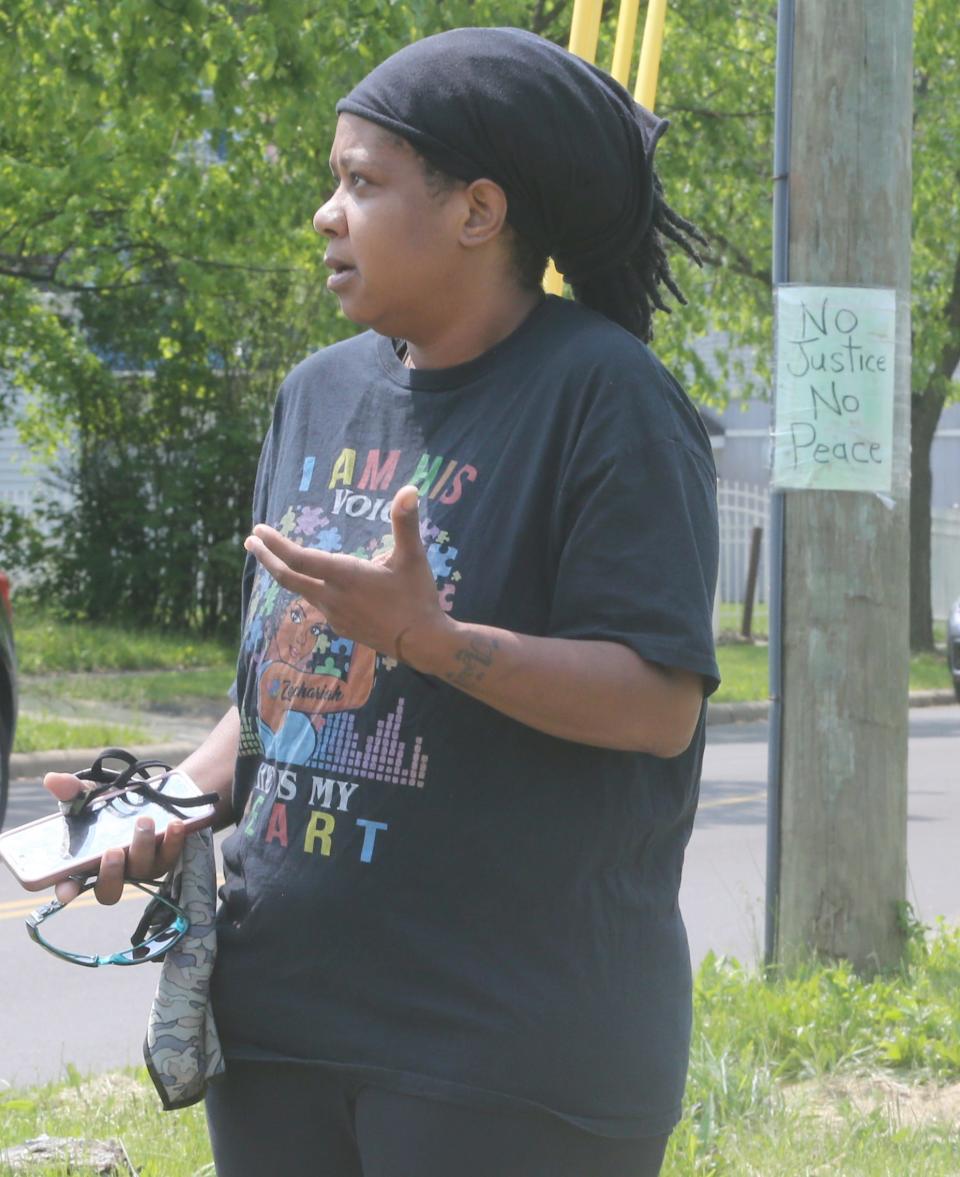
“It felt like a fire in my chest,” she said during a recent interview while standing at the corner of Copley Road and East Avenue.
Coteat, 42, who has had asthma since she was 11, said she didn’t seek medical attention, though she had trouble breathing for a few weeks.
“I think they went overboard,” she said. “We’re not being violent. We were peacefully protesting.”
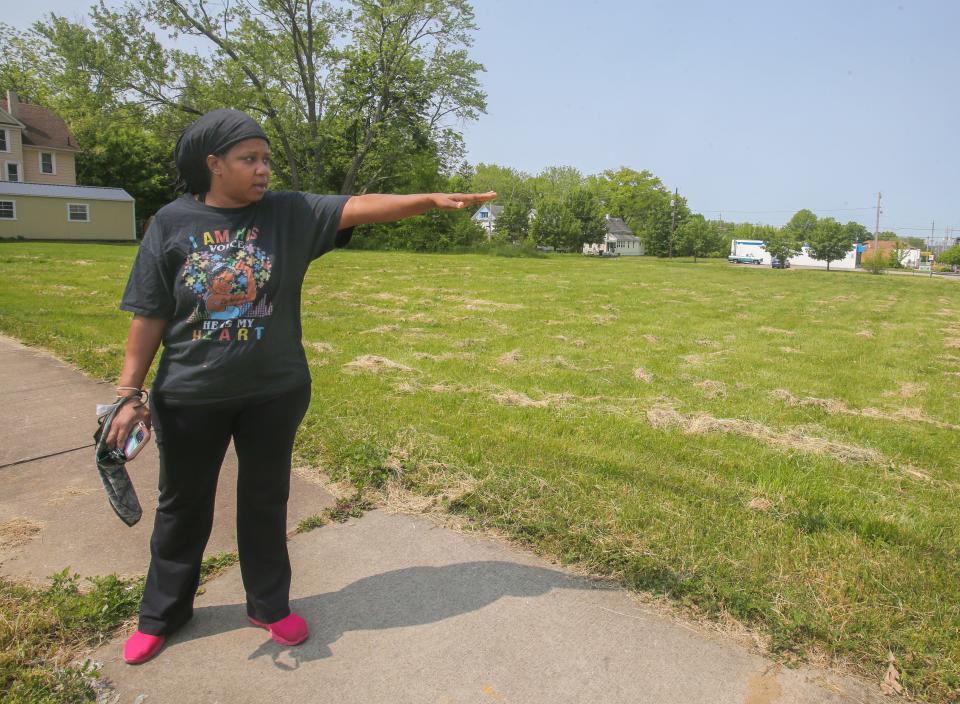
Teresa Gay-Williams said she went to urgent care six days after the protest because her eyes were still red and burning. She said she tried using milk and saline solution, but nothing seemed to help. She said doctors gave her an antibiotic solution and had her wear a bandage over her right eye for two weeks.
Gay-Williams said she was on the sidewalk, watching the protest, when she was exposed to tear gas and pepper spray.
“When someone is at a protest standing there, they don’t deserve to get hurt,” she said.
Gay-Williams, who co-founded the Coalition for a Safe Community of Akron with late attorney John Sharp, points to how police handled the Copley Road protest as an example of why reforms are needed.
“The police – they need to stop,” she said. “The taunting, the harassment, the killing. This has been going on for decades.”
Stephanie Warsmith can be reached at swarsmith@thebeaconjournal.com, 330-996-3705 and on Twitter: @swarsmithabj.
This article originally appeared on Akron Beacon Journal: Justified or 'unacceptable?' What Copley Road protest video shows

